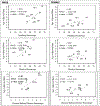Kidney cancer mortality disparities among Hispanics in the US
- PMID: 33862414
- PMCID: PMC8141025
- DOI: 10.1016/j.canep.2021.101938
Kidney cancer mortality disparities among Hispanics in the US
Abstract
Introduction: Kidney cancer incidence is increasing among Hispanics but rate differences by distinct group, such as Cuban, Puerto Rican, and Mexican have not been studied. To fill this knowledge gap, we use mortality data, reflecting fatal kidney cancers, to examine patterns by race-ethnicity, including detailed Hispanic groups, and correlate the mortality rates with each group's prevalence of known kidney cancer risk factors: smoking, obesity, hypertension, diabetes, and chronic kidney disease.
Methods: We used individual-level death data for California, Florida, and New York (2008-2018), and population prevalence data from the National Health Interview Surveys (2008-2018). Age-adjusted mortality rates (AAMRs) and regression-derived mortality rate ratios (MRRs) were computed. Pearson correlation analyses assessed the extent to which group-specific risk factor prevalence explained variability in observed AAMRs.
Results: US-born Mexican Americans and American Indians had the highest rates and MRRs compared to Whites: 1.44 (95 %CI: 1.35-1.53) and 1.51 (1.38-1.64) for Mexican American men and women, respectively, and 1.54 (95 %CI: 1.25-1.89) and 1.53 (95 %CI: 1.15-2.04) for American Indians. In contrast, non-Mexican Hispanics had lower rates than Whites. Among males, positive correlations between AAMRs and smoking, obesity, and chronic kidney disease prevalence by race-ethnicity were found.
Conclusion: Mexican Americans and American Indians are high-risk for fatal kidney cancer. Disparities are only partially attributable to higher smoking and obesity prevalence, and more so among men than women. A shared risk factor profile, as well as possible genetic similarities, may explain their disproportionately higher kidney cancer mortality, but further research is warranted.
Keywords: American Indian; Cuban; Mexican; Obesity; Smoking.
Copyright © 2021 Elsevier Ltd. All rights reserved.
Conflict of interest statement
Figures


References
-
- Henley SJ, Ward EM, Scott S, Ma J, Anderson RN, Firth AU, Thomas CC, Islami F, Weir HK, Lewis DR, Sherman RL, Wu M, Benard VB, Richardson LC, Jemal A, Cronin K, Kohler BA, Annual report to the nation on the status of cancer, part I: National cancer statistics, Cancer 126(10) (2020) 2225–2249. - PMC - PubMed
-
- Surveillance, Epidemiology, and End Results (SEER) Program ( www.seer.cancer.gov ) SEER*Stat Database: Incidence - SEER Research Data, 9 Registries, Nov 2019 Sub (1975-2017) - Linked To County Attributes - Time Dependent (1990-2017) Income/Rurality, 1969-2017 Counties, National Cancer Institute, DCCPS, Surveillance Research Program, released April 2020, based on the November 2019 submission.
Publication types
MeSH terms
Grants and funding
LinkOut - more resources
Full Text Sources
Other Literature Sources
Medical
Miscellaneous

